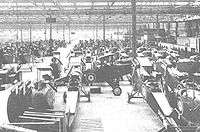National Aircraft Factory
During World War I, the importance of military control of the air became evident. The United Kingdom government therefore sought to significantly increase aircraft manufacturing capacity. In 1917 the Ministry of Munitions, then headed by Winston Churchill, commissioned the construction of National Aircraft Factories to significantly boost the rate and scale of production.

The erecting area of the National Aircraft Factory No.2 in late 1918 with de Havilland DH.9s under assembly
Four factories were commissioned
- National Aircraft Factory No. 1 at Waddon in Croydon, producing de Havilland DH.9[1]
- National Aircraft Factory No. 2 at Heaton Chapel, Stockport, managed by Crossley Motors and producing de Havilland DH.9
- National Aircraft Factory No. 3 at Aintree, Liverpool, operated by Cunard to produce Bristol F.2 Fighters[2]
- Ham near Kingston upon Thames, Surrey – leased and operated by Sopwith Aviation and producing Snipe, Dolphin and Salamander fighter planes. This, confusingly, was also referred to as National Aircraft Factory No. 2[3]
gollark: This will happen after RPNcalc68.
gollark: Apioprotocol 113-Sigma.
gollark: esoteric programming language.
gollark: Everyone, PRODUCE REVERSE POLISH NOTATION CALCULATOR.
gollark: You wake up at *6:30*? Weird.
References
- "1st De Havilland 9 produced at National Aircraft Factory No. 1". Flickr. Retrieved 7 June 2013.
- "Images of National Aircraft Factory No. 3, Aintree". Retrieved 7 June 2013.
- "National Aircraft Factory No.2 Freehold hereditaments [no ref. or date]". The National Archives. Retrieved 7 June 2013.
This article is issued from Wikipedia. The text is licensed under Creative Commons - Attribution - Sharealike. Additional terms may apply for the media files.